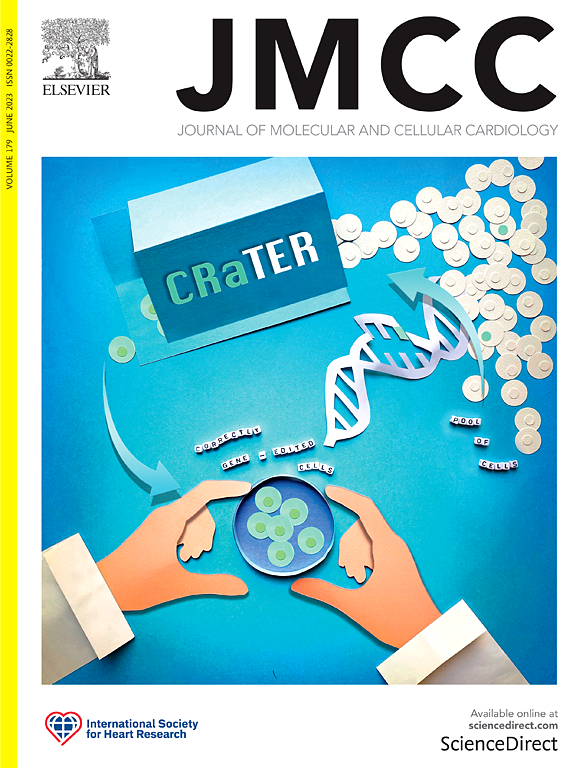与 CPVT 类心律失常相关的 SCN5A 功能增益突变的临床和电生理学特征分析
IF 4.7
2区 医学
Q1 CARDIAC & CARDIOVASCULAR SYSTEMS
引用次数: 0
摘要
本研究旨在描述在五个疑似儿茶酚胺能多形性室性心动过速(CPVT)家族中发现的 SCN5A 变体 I1333V 的特征。SCN5A 编码心脏电压门控钠通道 NaV1.5 的孔形成亚基。SCN5A 功能的获得会导致 3 型长 QT 综合征(LQT3),但它与 CPVT 的关系还存在争议。在五个家族中发现了19名携带I1333V变异体的患者,他们通常表现为运动诱发的心律失常,包括多形性室性早搏、室性心动过速、对偶心动过速和室性心动过速。QT 间期延长是一个不太一致的发现,而且心肌结构没有变化。在爪蟾卵母细胞中表达人类 NaV1.5/β1 复合物,使用 RNA 组合来模拟同卵野生型、杂合子和同卵 I1333V 突变情况。使用切开的卵母细胞凡士林间隙电压钳对细胞进行研究,以评估 I1333V 对 NaV1.5 功能的影响。NaV1.5(I1333V)通道需要较少的去极化才能激活,因此这种变异属于功能增益型。快速失活不受影响,动作电位(AP)钳夹显示晚期 Na+ 电流没有显著差异。根据人类心室肌细胞兴奋性的计算模型预测,I1333V 对 AP 持续时间没有影响;相反,该模型显示,在 AP 上冲期间,Na+ 流入更强,同时通过钠钙交换器输入的 Ca2+ 增加。最后,NaV1.5(I1333V)通道对 cAMP(模拟肾上腺素能刺激)的反应减弱,这也可能导致心律失常的发生。总之,I1333V 是 SCN5A 的功能增益变异,具有一系列独特的功能后果。它与以 CPVT 样和 LQT3 特征重叠为特征的心律失常疾病相关。我们的研究结果支持在对疑似 CPVT 进行基因筛查时应考虑 SCN5A。本文章由计算机程序翻译,如有差异,请以英文原文为准。

Clinical and electrophysiological characterization of a SCN5A gain-of-function mutation associated with CPVT-like arrhythmia
The present study aimed to characterize the SCN5A variant I1333V, found in five families with a history of suspected catecholaminergic polymorphic ventricular tachycardia (CPVT). SCN5A encodes the pore-forming subunit of the cardiac voltage-gated sodium channel NaV1.5. Gain of SCN5A function causes long QT syndrome type 3 (LQT3), but its involvement in CPVT is disputed. Nineteen patients harboring the I1333V variant were identified across five families, commonly presenting with exercise-induced arrhythmia, including polymorphic premature ventricular contractions, ventricular bigeminy, couplets, and ventricular tachycardias. Prolonged QT interval was a less consistent finding, and structural myocardial changes were absent. Human NaV1.5/β1 complexes were expressed in Xenopus laevis oocytes, using RNA combinations to emulate homozygous wild-type, heterozygous and homozygous I1333V-mutant conditions. Cells were studied using the cut-open oocyte Vaseline gap voltage-clamp to evaluate effects of I1333V on NaV1.5 function. NaV1.5(I1333V) channels required less depolarization to activate, classifying this variant as gain-of-function. Fast inactivation was unaffected, and action-potential (AP) clamp showed no significant differences in late Na+ current. A computational model of human ventricular myocyte excitability predicted no effect of I1333V on AP duration; instead, it showed stronger Na+ influx during the AP upstroke, concurrent with elevated Ca2+ import via the sodium‑calcium exchanger. Finally, NaV1.5(I1333V) channels exhibited a diminished response to cAMP (emulating adrenergic stimulation), which also likely contributes to arrhythmogenesis. In conclusion, I1333V is a gain-of-function variant of SCN5A with a unique set of functional consequences. It is associated with cardiac arrhythmia disease characterized by overlapping CPVT-like and LQT3 features. Our findings support that SCN5A should be considered in genetic screening of suspected CPVT.
求助全文
通过发布文献求助,成功后即可免费获取论文全文。
去求助
来源期刊
CiteScore
10.70
自引率
0.00%
发文量
171
审稿时长
42 days
期刊介绍:
The Journal of Molecular and Cellular Cardiology publishes work advancing knowledge of the mechanisms responsible for both normal and diseased cardiovascular function. To this end papers are published in all relevant areas. These include (but are not limited to): structural biology; genetics; proteomics; morphology; stem cells; molecular biology; metabolism; biophysics; bioengineering; computational modeling and systems analysis; electrophysiology; pharmacology and physiology. Papers are encouraged with both basic and translational approaches. The journal is directed not only to basic scientists but also to clinical cardiologists who wish to follow the rapidly advancing frontiers of basic knowledge of the heart and circulation.

 求助内容:
求助内容: 应助结果提醒方式:
应助结果提醒方式:


